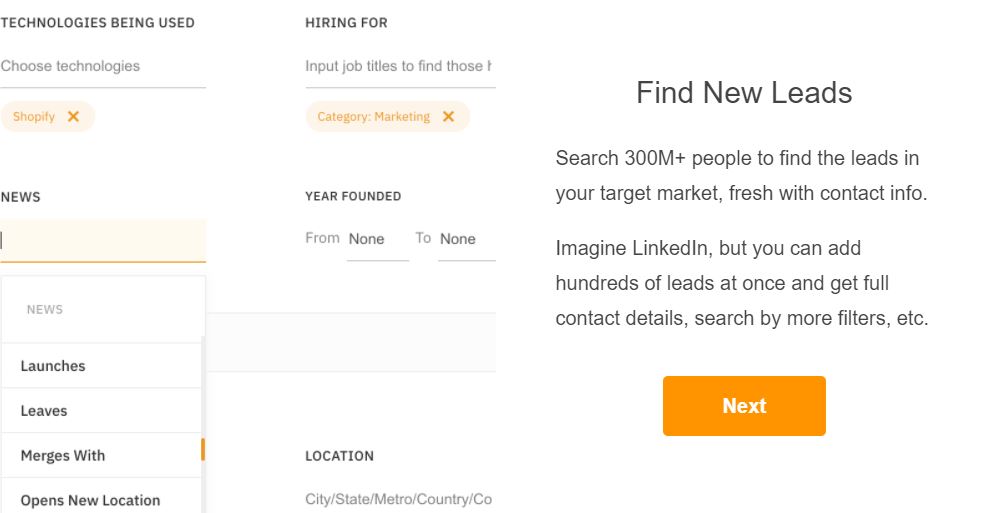What is Sales Outreach?
Sales outreach is the process of reaching out to and engaging potential customers to persuade them into making a purchase. You can use any communication channel – email, phone, or social media – and target both old customers and new prospects.
The goal of sales outreach is to build your prospect base so you can communicate with them in an organized and systematic manner.
Other goals of sales outreach include:
- Cultivating trust with customers,
- Establishing relationships with new leads,
- Educating customers on new product features.
Expanding on the definition of sales outreach that we have just given, a sales outreach campaign becomes the plan that connects your business with individuals and groups that you may be targeting with your sales efforts.
If structured the right way, a sales outreach campaign boosts brand awareness, facilitates promotion, and increases income.
How to Set Up a Sales Outreach Campaign
Step 1: Identify your ideal customer
To be successful in sales and email outreach, you must first identify and investigate your target demographic. This involves creating ideal client profiles as well as mapping your target demographic.
Consider one of your most loyal clients. From those, you’ve received monthly payments while receiving no complaints at all. Perhaps they’ve sent you a few additional potential customers who are similar to them. With that in mind, answer the following questions:
- What industry are they in?
- What are their roles?
- Do they spend money on something (for example, ads)?
Everybody wishes they could get a deal like that again, don’t they? Let’s see if we can track them down using LeadFuze!.
Hypothetical: A marketing agency selling a packaged service to improve the number of favorable reviews for local businesses.
In LeadFuze, you would log in, navigate to the “Leads” section, and begin searching for opportunities in your target positions and industries.

The proprietors or owners will be in charge of the roles that our hypothetical company would employ.
Although the owner will most likely make the final decision, it is beneficial to have the email addresses of influential individuals as well.
Step 2: Include extra & variable data into your ideal-buyer-persona search
It’s a good idea to create buyer personas for B2B companies to better understand your target market. This will help you better grasp their problems, buying motives, and responsibilities.
It’s possible to structure your sales pitch to appeal to the reasons for purchase and the benefits your customers will receive from your product or service by developing a clear picture of whom you’re selling to.
Agencies (and, for that matter, any business) that have a broad scope wind up with unsatisfactory messaging. When you narrow your emphasis and niching to the pain points, your outreach will be more effective, and you’ll receive more responses.
Use the following factors to trim down your lead results to the very best of the best.
Amount of Ad Spent:
In the case of leads who are currently spending money in ways that are similar to what you offer, they are more inclined to pay attention when they hear from someone who can provide them with greater outcomes.
Company Size:
Small businesses may not have the resources because of the low number of employees. In the event that you become too big, they may already have a solution in place.
Hiring:
If a company in your field is looking to fill a vacancy, you might be able to persuade them to use a service instead.
Tech Used:
If leads are utilizing marketing software tools, it is possible that they would like assistance in improving their outcomes and getting better results.
Company News and Updates:
Observe news releases, announcements, and publications. This company wants to find solutions, so pay attention to anything that can indicate such.
Step 3: Conduct your research
When doing this manually, you’d have to start with a list of leads and then go through the process of enriching that data on your own. Visits to social media profiles, as well as the use of various tools and websites, are all recommended.
Fortunately, LeadFuze can take care of everything for you.
You type in the info and hit the search button. The application then displays the number of leads that correspond to your search criteria.
Account-Based Research
Creating a “dream 100” list is actually an enjoyable thing to do. Basically, it’s the 100 different accounts that you’ve been dreaming of acquiring for your company. These are larger businesses that have the potential to significantly increase your income and profit.
This is only one example of how account-based marketing (ABM) can be used.
You’re focusing on specific brands, and you’re aiming to build out the profiles of possible decision-makers and anyone or anything else who might have an impact or influence on him or her.
Using ABM to search for outreach targets is also beneficial (aside from sales). We’ve used it to discover the perfect person for content collaborations and syndication channels.
Step 4: Choose a sales outreach channel
Prepare an outline of the channels that will be most effective for your target audience. Cold calling will be the preferred method for some (despite the fact that it takes so many attempts to speak with someone!).
Others may find that a particular strategy on social media is quite effective. Of course, LinkedIn is the most popular social media platform for B2B buyers, but if your target demographic is, for example, wedding photographers, they may be more active on Instagram than on LinkedIn.
Cold email outreach is a tried-and-true strategy that consistently produces the highest lead conversion rates and marketing ROI. In addition, according to HubSpot research, 4 out of every 5 B2B buyers prefer to be reached by email rather than any other method.
So, from here on out, I’m going to assume you’re communicating with people via email because not only does it produce the best outcomes, but we’re also specialists in the field. You can, however, modify this strategy to work for other channels.
Step 5: Target decision-makers first
Evaluate the information received from your ICPs and buyer personas and assign a ranking to your contact information based on the following criteria:
- How well a customer understands your solution,
- The amount of money they have available (budget),
- Influence they wield within their company.
Step 6: Automate your outreach with digital tools
While sales may be a difficult game to play, the appropriate outreach tool might help make things a little simpler. Sales outreach tools can assist you in developing a consistent stream of leads to support your firm.
If your organization is highly reliant on marketing and cold outreach, the appropriate outreach tool can literally save your life. The following tools can help save time and increase your confidence while approaching new leads.
Leadfeeder
Leadfeeder assists you in generating new leads by monitoring the behavior of your present website visitors. This is an excellent method for identifying warm prospects who are familiar with your target market.
Even if the majority of your website visitors never complete an interest form or subscribe to your email list, Leadfeeder can still help you identify prospects.
Leadfeeder can follow a prospect’s information as long as they are using a corporate IP address. When you have the contact details, you may begin identifying the organization’s decision maker. This will assist you in developing an outreach strategy for your prospects.
ConnectAndSell
If your sales approach is largely reliant on cold calling, you’ll want to explore ConnectAndSell. This system ensures that sales representatives have ten times the amount of live chats each day.
Many sales representatives spend an inordinate amount of time attempting to get consumers on the phone. According to the website of ConnectAndSell, 41% of conversations require at least two extra levels of navigation. Thus, rather than selling, you’re wasting a considerable amount of time attempting to identify the proper individual to speak with.
ConnectAndSell initiates the conversation on your behalf through a community of highly experienced agents. Once the prospect picks up the phone, the call is immediately sent to you, and you’ll receive detailed data on each call to aid in your decision-making approach.
Datanyze
Datanyze enables you to amass additional information on your prospects prior to contacting them. The company gathers information on your leads from a number of sources so that you can tailor your outreach properly.
Datanyze enables you to identify different target accounts, locate their contact information, and glean critical data about each business. From there, you may export and store your new contacts in your CRM.
Additionally, Datanyze will notify you of real-time purchasing signals from all of your customers. That way, you’ll be prepared to act when a client is prepared to invest in a service similar to the one you provide.
Step 7: Provide an offer based on pain points
Isn’t it great to have the email addresses of a couple of thousand people who suit your buyer profile? However, if you are unable to get a response from them, they will be of little use to you.
To get potential customers to talk to you, you’ll need to make them an offer or a deal. We are not referring to the product you are selling when we say “offer.” We mean your value proposition – why they must care. The solution your product will deliver.
90 percent of sales emails are overtly self-promotional, which can send prospects into cold mode. Every hour, thousands of businesses send sales pitches to their customers by copying and pasting them into their emails. Resist the temptation to do this.
Step 8: Deliver actual value
The goal of initial outreach is to initiate a conversation. It is far easier to get someone to talk to you than it is to keep a discussion continuing. In order to keep a conversation going, you must show that you have something to say that is worth hearing or talking about.

We recommend creating something of value (in the eyes of your prospects) and then giving it out free of charge. Here are a few suggestions of what may be your offer:
Consult: Service businesses could give a free consultation or audit to demonstrate to the prospective customers how they can gain from what they offer.
Content Exchange: As part of our efforts to reach out to the people we identified as perfect users of LeadFuze, we’ve done numerous guest blog posts.
Free tool: You could offer a tool for carrying out specialized tasks. NerdWallet does a brilliant job of this with its free financial calculators.
Invite: Live events or webinars make terrific icebreakers for leads. Those who turn up are giving you a clear clue they want to discuss.
Step 9: Conduct AB testing
A/B testing, popularly known as split testing, is a type of marketing test in which you divide your target in order to evaluate a variety of campaign versions and discover which works the best.
In other words, you may show one-half of your audience version A of a set of marketing materials while showing the other half version B.
To do an A/B test, you must generate two distinct versions of the same piece of content, each with a single variable altered. Then, you’ll present these two versions to two audiences of comparable size and assess which one performs better over a certain period of time.
A/B testing enables marketers to compare the performance of one version of marketing content to another.
Step 10: Record outreach results in your CRM
Keep all data, interactions, and outcomes in your customer relationship management or CRM tool.
Since any sales representative can pick up any account and know the specifics and history of that prospect, it makes the ongoing sales process easier. Sales representatives will be able to close more deals using this data.
Step 11: Follow up on your prospects
According to certain studies, on average 60% of customers will dismiss the first four sales messages they get. Yet, 70% of sales outreach email chains come to an end after the first unanswered message. And 40% give up after the first follow-up.
These statistics illustrate the importance of following up on your outreach efforts. Do not take the fact that your first message has not been responded to as a sign the prospect is not interested. They may not have time to process your offer at that time but may be more open to it at a later date.
That said, there has to be a time when you realize a prospect just isn’t going to respond. Experts consider 5 unanswered follow-ups to be a signal to give up and move on to other outreach targets.
Tips to Improve Your Sales Outreach
The fundamental concept of sales outreach is to offer an incentive in return for a favor rather than requiring people to make purchases from your business. Outreach marketing enables both sides to benefit from cooperative efforts.
Here are some of the benefits of sales outreach:
1 Increase your online visibility.
Online content is accessible from practically anywhere to anyone with an internet connection. To increase your visibility online essentially means improving content distribution and targeting, which you can do through SEO, social media marketing, PPC, and content marketing. You may also work with companies that will market your brand to their loyal client base, for example through guest blogging. This enables you to expand your reach globally, with the added benefit that your audience will develop independently of your involvement.
2 Improve your content quality.
It is feasible to increase user engagement by positioning and refining website content. Evaluate the strategies used by successful bloggers and authors to attract a larger readership. Modify effective promotional methods for your goods or services.
3 Target the right prospects
While it may seem like increasing your target count is the best way to scale your outreach efforts, it rarely brings in qualified prospects. Instead of targeting every lead that you can, have a clear vision of the perfect lead and target only those leads that match it.
4 Look for partners to collaborate with.
Small companies can pool their resources and help one another increase their client base. Businesses that are not in direct competition but which offer services or products that feed off each other are a perfect fit for this sales outreach strategy. An example is an auto repair shop and an auto insurance broker.
Don’t be afraid to send out chaser emails if you want your outreach campaign to be successful. You can even add a little humor to your follow-up emails to see if that works as a different strategy.
Here are some helpful tips to boost the chances of your follow-up emails getting read and responded to:
- Personalize your emails to boost open rates,
- Keep your emails short; they should be no more than 2-4 sentences.
- Make sure each email has a single call to action (CTA).
Expand Your Leads Basket With Sales Outreach
Sales outreach does not produce results overnight. It takes time and needs constant tweaking to achieve optimal results. As you discover more about your audience’s needs and demographic characteristics, there will also be a need to realign your strategy to make sure you are targeting the right people and using the right channels.
You have to stay engaged with your audience to be sure your messages are having the right effect and respond to any requests prospects may have. Make sure you don’t miss any touchpoint with the prospect and that may be the time a competitor swoops in and grabs the prospect.
Want to help contribute to future articles? Have data-backed and tactical advice to share? I’d love to hear from you!
We have over 60,000 monthly readers that would love to see it! Contact us and let's discuss your ideas!


